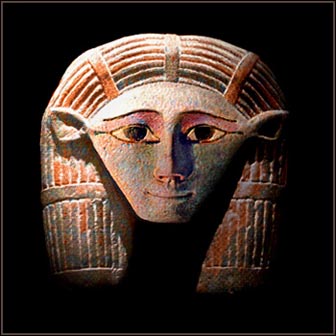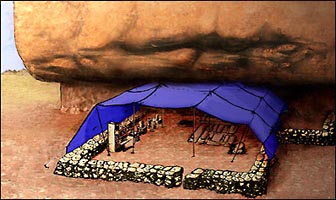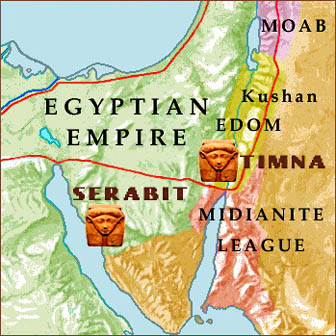HATHOR IN SOUTHERN PALESTINE

Hathor face from Timna (digital reconstruction )
|
Mistress of the Mines of Edom HATHOR AMONG THE SONS OF ESAU AND ISHMAEL We don't know exactly when Hathor decided to take up residence among the copper mines at Timna, across the Sinai from Egypt, in the Edomite Arabah. Certainly it was long after her worship had begun at the Egyptian temple in the Sinai. At the Serabit el-Khadim temple she was called the "Mistress of Turquoise" as early as Middle Kingdom times. When she extended her domain to the Land of Edom this appellation traveled with her. Since turquoise is not found in the Arabah, perhaps the title also meant "Lady of the Blue-Green Gemstones" and was appropriate amongst the copper ore mines of Timna. A temple was built for Hathor at the Timna site, a simple square structure which owed its design more to Canaanite influences than to anything from Serabit or Egypt. Since the earliest archaeological finds associated with this temple belong to the early 19th Dynasty, we know Egyptian priests and mining supervisors were there by the time of Seti I or Ramses II. They had probably begun to visit and occupy the site by the end of the Amarna era or shortly thereafter. This period in history coincides with the rise of kingdoms in Edom and Moab, and also with the most likely time for a proto-Israelite exodus from Egypt. When the first "Israelite" peoples were beginning to filter into the hills of Judah and scrub forests of Ephriam, Hathor was already residing in Palestine among the sons of Esau and Ishmael. TIMNA AND THE FOLLOWERS OF MOSES The followers of Moses probably knew of the Timna mines and passed through the region with their Kenite guides. For this to have happened on a large scale, the Egyptian presence in the area must have not yet been a formidable barrier to the wanderers, or else they came through after the Egyptians had departed. It is tempting to speculate that the proto-Israelites arrived in the area at the end of the Amarna era, just as the Egyptian temple was being planned. If this were so, their group may originally have been sent out from Egypt to help establish a "loyalist" presence among the nomads and semi-nomads of a pharaonic dependency in Edom. Although known pharaonic population relocation projects seem to have brought Asiatics and Libyans to Egypt and Nubia, some plans may have called for deportations in the opposite direction. In the time of Ramses III Philistines were settled north of Gaza; the Moses followers may have been part of some similar (but unrecorded) settlement project.If they reached Edom after making their covenant with YHWH at Horeb, there probably weren't too many Egyptian patriots left among the group. However, it is possible that the Mountain of YHWH was somewhere in Edom itself and that the "Yam Sup" mentioned in the Song of Miriam was the Gulf of Aqaba. Under these circumstances the proto-Israelites could have past near the site of the Hathor temple before reaching Horeb. It is not impossible that Hathor was already being worshipped at Timna when Moses' band came through.
It is commonly thought that Midianites and/or their Kenite associates worked the Mines of Timna, both under Egyptian rule and on their own when the Egyptian presence began to fade away. If this is true, we can only wonder what these semi-nomadic herdsmen, traders, smiths, and tinkers thought of Hathor. It is likely that they and the Edomite "natives" joined alongside their Egyptian masters in her worship. But once the minions of Pharaoh had withdrawn from the area Hathor's temple was destroyed. The site was then temporarily occupied by a "Midianite" tent-shrine, a sacred enclosure which may have shared some similarities with Moses' "tent of meeting" or the tent where Phinehas ben Eleazar ben Aaron killed Cozbi the Midianite princess (Numbers 25). 
"Midianite" Tent Shrine over Timna Temple Ruins HATHOR AND THE ASHERAH OF YHWH Assuming that some of the south Palestinian tribes that passed through and occasionally camped in the region around Timna stopped to pay their respects to the Mistress of the Mines, we can guess that a few worshippers of El, Baal, and YHWH also called upon Hathor to bless their copper trading business and to give them many healthy offspring. Hathor had no trouble keeping company with her Palestinian sister goddesses and both El and YHWH had goddess consorts in the cults maintained by at least some of their devotees. So perhaps Hathor's fertility-goddess aspect lingered on in the Arabah after her Egyptian priests had departed. Here and there a glimpse of Hathor's "scroll" wig, headdress, and horn enclosed solar orb can be found among the many little fertility figurines kept by families (including Israelite families) from the Sinai to the Euphrates. While most of this iconography probably drifted in with Byblos merchants and the Egyptian occupation forces, it was equally familiar at the Timna temple and some of the same symbolism may have been carried north by Kenite traders and Edomite nomads entering the lands which became Judah and Israel. Once the Levites established their state cult in Judah, YHWH's earlier occasional consort(s) disappeared from official Israelite religion. Occasionally a ruler in Judah or Israel would bring some Canaanite goddess back into the temple or town shrines and an Israelite equivalent of Astarte, Qadesh, or Hathor briefly showed her face in the YHWH cult. But, in the end, the "Hebrew Goddess" was lost to what became mainstream Judaism. One interesting manifestation of the female divine power continued to accompany the God of Moses even after he had abandoned any local goddess consort-- this was the "Ashrah," a wooden "fertility pole" which stood beside his altar. Since Hathor was also a tree-goddess, this may have been her final, fading presence in the Lord of Hosts' court. Finally the day came when the last Ashrah was cut down, the last cake baked for the "Queen of Heaven" was eaten, and the last clay fertility figurine was smashed. If goddesses cry, perhaps Hathor looked through her Timna scrapbook pictures, shed a tear, and said "good-bye." text and graphics enhancement by Dale R. Broadhurst Timna Hathor face and Midianite shrine scans courtesy of Chris King Visit his Genesis of Eden web site. |
return to top of page
The Sistrum in the Sinai | Hathor Home Page | Dale R. Broadhurst Home Page
last updated: Feb. 1, 2006
